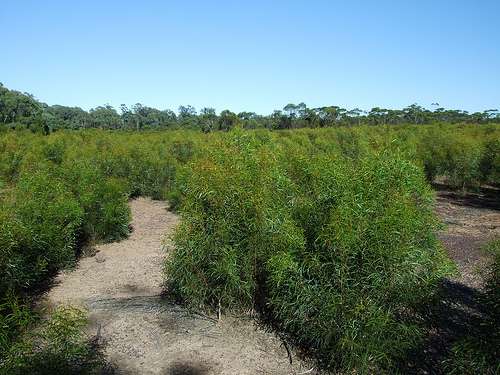Block cropping pitted against integration method

A local study has revealed how different ways of planting and growing mallee (small to medium-sized Eucalyptus trees) around a pasture can affect overall biomass and crop production.
The study, conducted 48km from Esperance, focused on the amount of bio-feedstock that mallee crops produced, in conjunction with the amount of grain produced from conventional crops.
Department of Agriculture and Food WA researcher and lead author Dr Robert Sudmeyer says the study findings will assist farmers in picking the best method for harvesting either mallee, conventional crops, or both.
"If the aim is to grow mallees and you don't care if you lose some crop production then growing them in belts [integration] is best," Dr Sudmeyer says.
"If you want to grow crops then segregation is best, and if you already have mallee belts and want to maximise crop production, then root pruning and harvesting the trees is best."
Dr Sudmeyer says the study examined mallee agroforestry (growing mallees in two-row belts with the belts separated by strips of annual cropland), and mallee monoculture (growing the mallees in solid blocks to the exclusion of other enterprises).
"At this site, mallee monocultures harvested on a rotation of five or more years would produce more biomass than crop monocultures, and mallee agroforestry would produce the least biomass because of the uncropped areas next to the trees," he says.
"While it was possible to manipulate the relative productivity of mallees and crops by root pruning the mallees, it doesn't increase the biological productivity of the system as a whole."
Root pruning curbs mallee growth
Dr Sudmeyer says root pruning the mallees reduced the lateral extent of mallee roots, so mallees had less access to water, and as a consequence, grew less.
"Likewise, harvesting the mallees removes all of their above ground growth," he says.
"As the mallees take some time to re-establish their original leaf area, they photosynthesise less than unharvested trees and so produce less biomass and use less water."
Dr Sudmeyer says planting mallees in two row mallee belts (integration) has been widely promoted as the best way to grow the trees.
"However, this comes at a cost in terms of reduced crop growth and reduced total [mallee and crop] biomass production on a per hectare basis," he says.
"If we want to maximise the production of food and biomass from a given area of land it is better to segregate the crop and mallees rather than integrate them."
More information: "Competition for water between annual crops and short rotation mallee in dry climate agroforestry: The case for crop segregation rather than integration," Biomass and Bioenergy, Volume 73, February 2015, Pages 195-208, ISSN 0961-9534, dx.doi.org/10.1016/j.biombioe.2014.12.018
Provided by Science Network WA




















